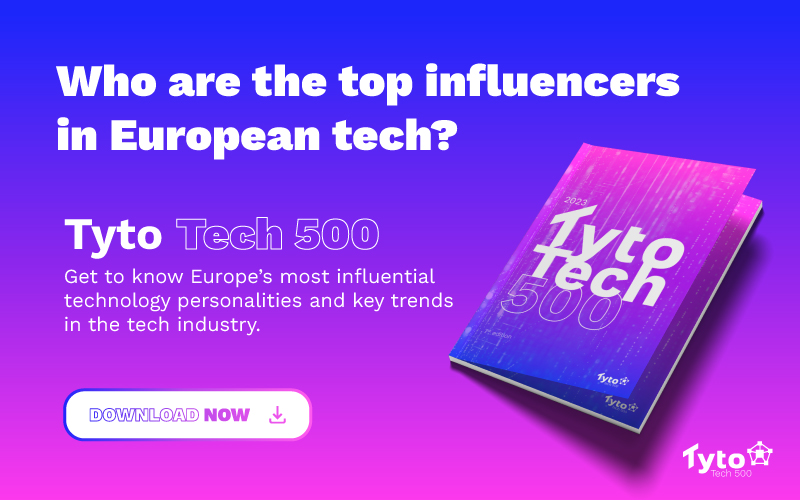
The year of AI – entrepreneurs’ tech & industry predictions for 2024

FinTechEnviroTechHealthTechInsurTechMarTechPropTechRecruitment & HRRegTechRetail
Technology moves at great speed and new regulation often follows – which is why it is essential for businesses to keep their fingers on the pulse of what is coming next.
Similarly, as industries and working practices constantly move forwards, there is an ever-present danger of being left behind.
We asked UK entrepreneurs across several sectors – many of whom featured in our Tech 50 innovation rankings in 2022 – for their tech and industry predictions in the 12 months ahead.
Unsurprisingly, artificial intelligence is again front and centre of their thoughts.
The year of AI (again)
Josh Hough (below), MD at home care management software firm CareLineLive – second on our HealthTech 50 ranking this year – is cautious that AI may prove to not be the answer everybody thinks it is.
“It will certainly become even more of a buzzword than it is now, but I’m not 100% confident that by the end of the year, people are going to think it’s as game-changing as they do right now,” he tells BusinessCloud.
“Healthcare must remain person-centred at all times. Ultimately I think we’ll quickly realise that as good as AI is, it does remove some of the real ‘person-centred care’ that the CQC (Care Quality Commission) wants to see. Bringing AI into home care is going to be a fine balancing act between what helps, and what actually starts to reduce the personal service these agencies must offer.”
CareLineLive – all-in-one home care management software
Zandra Moore, CEO at data intelligence firm Panintelligence, expects 2024 to be the year of pragmatic AI – with “the focus shifting from a generative AI spree to more savvy innovation”.
“Predictive analytics will provide users with crystal ball functionality, ever-smarter deep learning will tackle ever more complex problems, and causal AI will take the role of ethical hero, helping to explain decisions and ensuring AI efficacy,” she continues.
“AI innovation in SaaS isn’t about code: it’s about empowering every individual and business with the tools to thrive in the age of intelligence. SaaS is the gateway through which most people will access powerful technologies like AI, and as the AI rush continues into 2024, SaaS companies are ensuring that the potential of these cutting-edge tools reaches every corner of the business world.”
Stéphie Ndinga, chief compliance officer at Swan, says FinTechs will gain a heightened ability to monitor all facets of their business and assess risk simultaneously.
“Savvy FinTechs will harness AI in this way to integrate compliance into all workflows, which will require the development of departments devoted solely to the implementation of compliance across the product,” she adds. “Too often, organisations separate compliance from their end products, rather than viewing them as a single intertwined entity.
“Alongside this, regulators will also increase their use of AI in the coming year, tapping it to conduct more efficient analyses of companies’ reputations and risk.”
You can read more from Ndinga at the link below.
Crucial compliance trends for FinTechs in 2024
James Ramsden, data science capability lead at Naimuri, highlights how AI is changing our relationship with data.
“Human-authored content is being diluted rapidly by machine-authored content and AI-authored content,” he says. “The really interesting problem is that it will get worse.
“This is really important because of human biases around data: the way we tend to believe the first version we hear over subsequent versions and believe things that chime well with our viewpoint rather than credit things because they are well provided, cited, or argued. These powerful AI models will only become more powerful, and data on the internet will be dominated by machine-generated output.”
James Bunting (below), CEO of longstanding software development business Leighton, says the trajectory of AI is set to change.
“While there was a lot of noise around AI this year, examples of impactful use cases were relatively scarce. I think this will start to change in 2024, with a surge in practical applications and tangible outcomes,” he explains.
“I also think sustainability will take centre stage in software engineering, with an emphasis on the environmental impact of technology. As AI is known to be resource-intensive, it will be interesting to see how these two things come together and will certainly be a key consideration for businesses adopting AI.”
The landscape is evolving at an unprecedented pace – a seismic shift where AI is becoming a focal point for C-suite executives, says Jeff Dewing, CEO of Cloud, second on our PropTech 50 ranking this year.
“In 2024, AI’s role will transcend routine automation, emerging as a catalyst for heightened productivity and innovation. Leaders actively immersing themselves in various AI tools are poised to make informed decisions, paving the way for seamless adoption and mitigating resistance or uncertainty to change,” he explains.
“In this landscape, empowering employees with AI tools is paramount. It’s vital that leaders upskill their employees with AI tools, equipping them with the knowledge and confidence to work alongside this technology. In 2024, successful AI implementation will hinge on creating an environment where it augments human capabilities, rather than replacing them.”
Cloud
Pete Casson, CTO at No.1-ranked FinTech 50 scaleup Collctiv, doesn’t want to jump on the AI bandwagon… nevertheless he acknowledges that “the rise of accessible AI tools has disrupted the industry”.
“These tools are great in complementing existing processes and systems – for example fraud prevention and detection. It has reduced the barrier to sophisticated data processing and analysis for smaller businesses and startups. AI tools have enabled startups to move faster and create businesses that are disrupting the legacy incumbents.
“We’ll continue to see AI dominate the tech landscape, but I expect to see the start of consolidation of AI companies now that the sector is understanding which companies are a feature rather than a business.”
https://www.youtube.com/watch?v=videoseries
He adds: “Virtual reality and augmented reality will experience a decent jump in adoption with Apple’s Vision Pro set to be released. Despite its high price tag, it’ll be the first VR/AR product that is usable for most people in the way that the first iPhone was.
“It’s the start of a long journey, but if the mobile phone is anything to go by, in the next 10 years AR/VR will become the new norm.”
Collctiv – Group payments. Sorted
A return to the office?
Cloud boss Dewing says whether employers will force workers to return to the office is the million-dollar question in 2024.
“Fixed structures or mandating 2-3 days in the office can constrain employees,” is his view. “My proposition? Radical flexibility, which allows employees the autonomy to choose their working arrangements everyday.
“A successful remote workforce requires a results-driven mindset and a culture of trust. Leaders should focus on objectives and clearly communicate expected outcomes to evaluate performance.
“In 2024, leaders must confront talent expectations and prioritise autonomy, learning, belonging, and balance. Flexibility is not a perk; it should be non-negotiable. In my experience, where I’ve more than doubled engagement levels, I’ve seen the transformative power of this first hand.”
Anna Brailsford (below), CEO of Code First Girls, says the challenge of recruitment remains.
“The industry continues to face a major skills gap, with more roles being advertised than there are candidates – a problem that has been plaguing the sector for years and shows no sign of slowing down,” she says.
“Women still remain seriously underrepresented in the tech industry, though the dial has been moving. Therefore, as we look towards 2024, we’ll start to see more companies looking beyond their usual recruitment pools and progression tactics – wanting to upskill women and those career-switching from other industries in order to utilise their skillsets and unique perspectives.
“With diverse teams proven to perform better (+35%), innovate better (1.7x) and drive diversity of thought, tech companies can only benefit from a widening their recruitment pool – not only to fill the talent gaps they so desperately need.”
The funding landscape
Investors and markets are beginning to loosen up, according to CareLineLive MD Hough, but it remains challenging for businesses to raise capital – and in particular at valuations that continue to support the founder.
“Cash maximisation is going to be key [for new startup founders] – inflation and political uncertainty mean that stretching cash and building as strong a pipeline as you can is going to be critical,” he says.
“Large valuations on cash-burning businesses are becoming ever more rare. For the scaleup tech sector, the challenges are going to continue to come from the financial and political environment. I think a likely change in government is creating a sense of trepidation within SMEs and scaleup businesses and I worry that support for these businesses may be reduced or held off for some time.
“Ultimately, we’ve got to continue to evidence that businesses like ours are the ones enabling jobs for those who may not get them in the corporate world. The scaleup sector is flexible enough to keep the wheels of the economy turning.”
Casson of Collctiv expects the funding landscape to improve in 2024.
“2023 was dire for any investment, but there is now a backlog of capital that has to be deployed,” is his view. “We’re already seeing improved investor activity both in the UK, Europe and US, and this will ramp up throughout 2024.
“The expectation of investors has definitely changed though, gone are the days of growth at all costs, the shift to building profitable, sustainable businesses is here to stay.”
Speeding up
Digital transformation projects will have to be sped up from the traditional 12-18-month timeline, says Leighton’s Bunting.
“I think over the next year organisations are going to prioritise swift project delivery,” he says. “The focus will shift to delivering tangible business value quickly and iteratively building upon successes.
“Proof-of-concepts will become commonplace, not only for internal process enhancements but also for external customer products and features. This iterative approach will streamline development cycles, fostering agility and responsiveness to changing market dynamics.
“By prioritising business value and embracing PoCs, organisations are gearing up for a more dynamic and customer-centric evolution in the technology sector.”
Drive to Net Zero
Toby Gill, CEO at No.2-ranked EnviroTech 50 star IPG Energy – behind clean, fuel-agnostic renewable generators for industry – points to initiatives such as the Zero Diesel Road Map and projects such as the Lower Thames Crossing.
“These are all echoing a renewed effort towards eliminating diesel and diesel-powered equipment from construction sites,” he claims. “As well as the greater innovation and deployment of digital technologies that will help improve efficiency, reduce waste and eliminate errors, we expect to see technologies across the energy value chain have a big impact on moving towards diesel-free construction. Further innovations in the storage and distribution of renewable fuels, in power generation and in the growth of green fuel supply chains are all set to follow, with the latter including multi-fuel generators and existing gensets retrofitted to operate on low-percentage blends of renewables.”
He adds on the barrier of cost: “The UK government can learn from peers in the USA and Europe, where subsidies are placed on renewables like hydrogen to bridge the cost disparity with diesel, reviewing how taxation can create stronger incentives to go greener. In the UK today, liquid renewables like biodiesel and bioethanol are subject to the same taxes as diesel, meaning the accompanying fuel duty rate of almost 53p per litre must be paid.
“Similarly, the fuel duty for gaseous renewables such as hydrogen is the same as for natural gas; a fuel duty of just over 22.5p per kg, unless used in a fuel cell. If the government is to stimulate the transition away from diesel by enabling the use of renewables, it should consider a tax break for the use of any renewable fuel in any technology that can do so cleanly, as is the case in the USA and elsewhere in Europe.”
IPG Energy – Reinventing fuel-based power for the net-zero future
The power of social shopping
Michael Knowles, MD at ROAR Digital Marketing, looks ahead to the changing landscape of content generation. Acknowledging the rise of short-form content as people’s attention spans reduce, he says there will always be a role for longer-form content – and that generated by users.
“We’ve seen the rise of TikTokers and influencers promoting products on behalf of businesses and, although it’s not a new method of marketing, it is now flooding the digital stratosphere,” says Knowles.
“When people are browsing products to consume, seeing either a famous person speaking favourably about the product is aspirational for the ‘ordinary’ member of the public. However, one of the most effective marketing tools is UGC as watching a video of a like-minded individual explaining how good a product is instantly hits home with the consumer about how that item will similarly benefit their lives.
“The effectiveness of this method is confirmed by both Tik Tok and Instagram which have in feed and in post shopping options, allowing consumers to quickly and easily buy the products being used and discussed by the influencer. We predict that ‘consumer reviews’ will become the dominant form of marketing because seeing products and services in actual use from ‘real sources’ sells.”
Connections with customers
Achille Traore (below), CEO at customer loyalty platform White Label Loyalty – which featured on our MarTech 50 ranking this year – says in the next 12 months brands will shift focus from customer acquisition to customer retention.
“They will invest more in sustainable growth, rather than growth at any cost. Achieving this means focusing on loyal customers and finding more ways to stand out from the competition and form meaningful relationships with customers,” is his view.
“Predictive AI will become even more important: this invaluable instrument will let brands easily analyse data generated by loyalty programmes and uncover insights to offer personalised experiences to customers, leading to a shift in how we think about rewards.
“Brands are striving to create strong emotional connections and truly offer value to their customers, and this also means finding new ways of rewarding customers for things other than just purchases. Rewarding customers for engaging with branded content, such as visiting blogs or sharing on social media, will become a huge factor in driving loyalty in 2024.”
White Label Loyalty
Insurance trends
Megan Bingham-Walker (below), CEO at eCommerce parcel insurance platform Anansi Technology, a star of our InsurTech 50 ranking, says we will see embedded insurance coming of age in 2024.
“Businesses are starting to move on from seeing embedded insurance as limited to applications of insurance upselling in the checkout function for purchases – for example, extended product warranty,” she explains.
“We’re going to see more applications of embedded insurance in a business insurance context: businesses are already gathering vast amounts of risk data and sharing in accounting tools, telematics and other databases. I expect to see many more insurance products tapping into these sources to power their products, similar to Anansi’s embedded goods-in-transit insurance.”
Anansi – Ecommerce parcel insurance with automatic claims
Genasys Technologies was second on the InsurTech 50. Group CTO Craig Olivier (below) says it has seen a positive shift over the last 12 months as smart insurance businesses recognise that to achieve commercial success their core tech platform must be API-enabled – linking them to an evolving ecosystem of partners.
He adds: “In the coming months we’ll start to see insurance businesses using ‘suggestive AI’ and large data interpretation to pull together different data sources to better understand risk in real-time and so improve the accuracy of underwriting. As a result, insurance businesses will be empowered to deliver a personalised experience for policyholders, helping to transform the claims experience and ultimately how consumers view the value of insurance.
“But how can an insurance business plug these AI data products into its existing core tech? InsurTech partners are the glue between commercial aspiration and the policyholder experience as we provide a core tech platform which gives insurance businesses the flexibility, control and advanced functionality to plug into multiple data sources and support innovation via an ever-evolving partner ecosystem.”
Genasys – Insurance software with a difference








